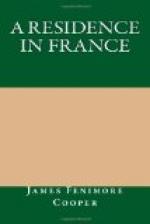Rudesheim was a Roman station, and it is probable that its wines date from their government. There is still a considerable ruin, belonging, I believe to the Count of Ingelheim, that is supposed to have been built by the Romans, and which has been partially fitted up by its proprietor, as a place of retreat, during the vintage. This is truly a classical villagiatura. It was curious to examine these remains, which are extensive, so soon after going over the feudal castle, and it must be confessed that the sons of the South maintained their long established superiority here, as elsewhere. Ingelheim, where Charlemagne had a palace, and where some pretend he was born, is in plain view on the other side of the river, but no traces of the palace are visible from this spot. Such is the difference between the false and the true Roman. There is also a ruin, a small high circular tower, that is connected with our inn, forming even one of our own rooms, and which is very ancient, probably as ancient as the great Frank.
We left Rudesheim after breakfast, driving quite near to the hill of Geissenheim, and quitting the main road, for the purpose of visiting Johannisberg, which lies back a mile from the great route. We wound our way around the hill, which on three sides is shaped like a cone, and on the other is an irregular ridge, and approached the house by the rear. If you happen to have a bottle of the wine of this vineyard (real or reputed, for in this respect the false Simon Pure is quite as likely to be true as the real,) you will find a sufficiently good resemblance of this building on its label.
I can give you no other reason why this wine was formerly so little known, while that of Hochheim had so great a reputation, than the fact that the mountain, house, and vines were all the property of a religious community, previously to the French revolution, and that the monks probably chose to drink their own liquors. In this particular they were unlike the people of Brie; for walking one day with Lafayette, over his estate at La Grange, I expressed surprise at seeing some labourers making wine. “Oh, yes, my dear friend,” returned the General, “we do make wine here, but then we take very good care not to drink it.” The monks of Johannisberg most likely both made wine and drank it.
Johannisberg has changed owners several times. Shortly after our return from the journey on the Rhine of last year, chance placed me, at Paris, at table between the charge d’affaires of Nassau and the Duc de Valmy. The former observed that I had lately been in Nassau, and asked how I liked the country. Under such circumstances one would wish to praise, and as I could honestly do so, I expressed my admiration of what I had seen. Among other things, I spoke of its rich vineyards, and, as a matter of course, began to extol that of Johannisberg. The more I praised, the graver the diplomate looked, until thinking I had not come up to his own




